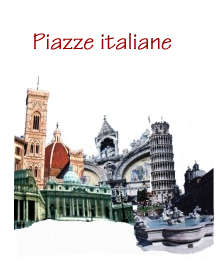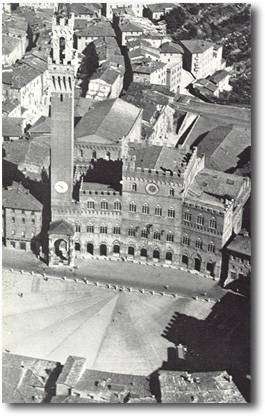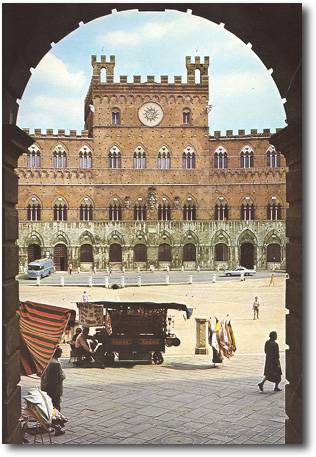
Piazza del Campo
Since the origins of the celebration,
the historic procession has preceded the running of the Palio as solemn
civic, historic and triumphal choreography. In its current form, it
is a commemorative representation of the institutions, the customs and
the greatness of the ancient Sienese Republic, with special regard for
the Contradas, which form the principal parts of the procession with
their groups of costumed marchers called Comparse.  The
realization of the costumes, which was made possible by a substantial
financial contribution from the Monte dei Paschi di Siena bank, was
seen to by the Municipality and by the individual Contradas, which keep
and care for the uniforms in their respective historic-monumental locales.
The Historic Procession which today parades in Piazza del Campo comprises
14 groups for a total of nearly 400 costumed participants. In the early
afternoon of the day of the Palio, the Comparse of the Contradas and
some of the costumed representatives of the Municipality gather in the
courtyard of the Palace of Justice and, on the order of the Field Marshall,
align themselves in Piazza del Duomo beside the cathedral, parading
between the two dense wings of the crowd through Via del Capitano, Piazza
Postierla, Via San Pietro, Via del Casato di Sopra and Via del Casato
di Sotto, at which point they reach the other representatives of the
Municipality. The Historic Procession enters in Piazza del Campo at
the first toll of the "Sunto," the great bell atop the Torre (Tower)
del Mangia dedicated in 1665 to the Risen Virgin, patron and queen of
the city. It is the most recent specimen in a series of "bells of the
people," the most ancient having been mounted atop the Tower in 1344.
For the entire duration of the Procession, "on the piazza falls the
sound of bronze," as Eugenio Montale wrote in his "Palio." Seventeen
pairs of Alfieri -- flag-throwing standard-bearers -- stopping at established
points in the Piazza and following the roll of the drummers, carry out
the "sbandierate" (flag displays). The flag display is composed of single
movements, the "fioretti" (embellishments) assembled in figures of various
lengths, combined according to the seventeen schools of the Contradas,
which pass the techniques from generation to generation. The flag displays
culminate in spectacular high-flying finales. Between stops, the Comparse
parade to the roll of the "passo (pace) della Diana": the musicians
of the Palazzo Pubblico play the Palio March. The central point of the
Procession is the passage of the "carroccio," the modern counterpart
of the triumphal carriage of the Republic upon which is mounted the
Palio, a banner of painted silk, the prize of the race. Having finished
the turn around the Piazza, the marchers take their places on the platform
of the Comparse, the Palio is hoisted onto the judges' platform and
each of the seventeen Alfieri performs the flag display of Victory to
the roll of his own Contrada's drum. Then, the firecracker explodes
and the jockeys ride out of the Grand Entrance of the Palazzo Comunale.
The
realization of the costumes, which was made possible by a substantial
financial contribution from the Monte dei Paschi di Siena bank, was
seen to by the Municipality and by the individual Contradas, which keep
and care for the uniforms in their respective historic-monumental locales.
The Historic Procession which today parades in Piazza del Campo comprises
14 groups for a total of nearly 400 costumed participants. In the early
afternoon of the day of the Palio, the Comparse of the Contradas and
some of the costumed representatives of the Municipality gather in the
courtyard of the Palace of Justice and, on the order of the Field Marshall,
align themselves in Piazza del Duomo beside the cathedral, parading
between the two dense wings of the crowd through Via del Capitano, Piazza
Postierla, Via San Pietro, Via del Casato di Sopra and Via del Casato
di Sotto, at which point they reach the other representatives of the
Municipality. The Historic Procession enters in Piazza del Campo at
the first toll of the "Sunto," the great bell atop the Torre (Tower)
del Mangia dedicated in 1665 to the Risen Virgin, patron and queen of
the city. It is the most recent specimen in a series of "bells of the
people," the most ancient having been mounted atop the Tower in 1344.
For the entire duration of the Procession, "on the piazza falls the
sound of bronze," as Eugenio Montale wrote in his "Palio." Seventeen
pairs of Alfieri -- flag-throwing standard-bearers -- stopping at established
points in the Piazza and following the roll of the drummers, carry out
the "sbandierate" (flag displays). The flag display is composed of single
movements, the "fioretti" (embellishments) assembled in figures of various
lengths, combined according to the seventeen schools of the Contradas,
which pass the techniques from generation to generation. The flag displays
culminate in spectacular high-flying finales. Between stops, the Comparse
parade to the roll of the "passo (pace) della Diana": the musicians
of the Palazzo Pubblico play the Palio March. The central point of the
Procession is the passage of the "carroccio," the modern counterpart
of the triumphal carriage of the Republic upon which is mounted the
Palio, a banner of painted silk, the prize of the race. Having finished
the turn around the Piazza, the marchers take their places on the platform
of the Comparse, the Palio is hoisted onto the judges' platform and
each of the seventeen Alfieri performs the flag display of Victory to
the roll of his own Contrada's drum. Then, the firecracker explodes
and the jockeys ride out of the Grand Entrance of the Palazzo Comunale.
Authors: Federico
